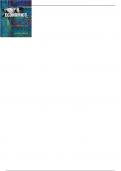Exam (elaborations)
Test Bank For Economics 10th Edition by Roger
- Module
- Economics - Test Bank
- Institution
- Economics - Test Bank
Chapter 3—Supply and Demand: Theory MULTIPLE CHOICE 1. The law of demand states that price and quantity demanded are a. directly related, ceteris paribus. b. inversely related, ceteris paribus. c. independent. d. positively related, ceteris paribus. ANS: B PTS: 1 DIF: Easy NAT: Analytic LO...
[Show more]



